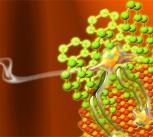
Submitted by Dr Nalin Patel on Thu, 09/10/2014 - 17:12
A new method for transferring energy from organic to inorganic semiconductors could boost the efficiency of widely used inorganic solar cells.
The team, from the University of Cambridge, have successfully harvested the energy of triplet excitons, an excited electron state whose energy is harvested in solar cells, and transferred it from organic to inorganic semiconductors. To date, this type of energy transfer had only been shown for spin-singlet excitons. The results are published in the journal Nature Materials.
“The key to making a better solar cell is to be able to extract the electrons from these dark triplet excitons,” said Maxim Tabachnyk of the University’s Cavendish Laboratory and a Winton Scholar, the paper’s lead author. “If we can combine materials like pentacene with conventional semiconductors like silicon, it would allow us to break through the fundamental ceiling on the efficiency of solar cells.”
Using state-of-art femtosecond laser spectroscopy techniques, the team discovered that triplet excitons could be transferred directly into inorganic semiconductors, with a transfer efficiency of more than 95%. Once transferred to the inorganic material, the electrons from the triplets can be easily extracted.
“Combining the advantages of organic semiconductors, which are low cost and easily processable, with highly efficient inorganic semiconductors, could enable us to further push the efficiency of inorganic solar cells, like those made of silicon,” said Dr Akshay Rao, who lead the team behind the work.
The team is now investigating how the discovered energy transfer of spin-triplet excitons can be extended to other organic/inorganic systems and are developing a cheap organic coating that could be used to boost the power conversion efficiency of silicon solar cells.
Further details can be found via this link

